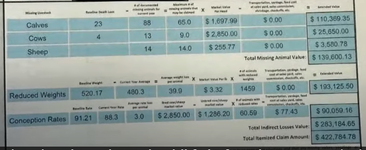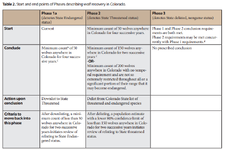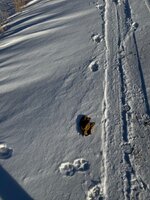jmez- This claim looks legit to me I will be curious to see how it is questioned and scrutinized and what the final payout truly is at the end of all this. Keep in mind all of these cost are with less than 12 known wolves on the ground as of now.....
From the screen shot from this news story
@ 00:52 about the ballooning costs of wolves it looks to me like claimants filed an itemized claim form. It looks like most of the money owed is not from actual confirmed wolf depredation deaths but lost productivity from open cow dues to lower than 3 year average conception rates and reduced weight on calves sold due to stress and pressure from the wolves. The top line of "Calves" is interesting to me as it shows a 3 year average loss of 23 calves an this year it is 88. That is eye opening to me.

The itemized claim requirements for production losses are spelled out on page 34 of the Colorado Wolf Plan.
https://cpw.widencollective.com/assets/share/asset/wixcpz0wez
For livestock owners who choose to itemize production losses
claiming missing livestock the following apply (this option is only
applicable for calves, yearlings, and all classes of sheep):
• Missing calves, yearlings, and sheep can be claimed if two
conditions are met:
° 1) Livestock owners must have a confirmed depreda-
tion event (injury or death) due to wolves to qualify
for the itemized production losses
° 2) The livestock owner must reasonably believe that
livestock reported as missing were lost to wolves and
not to other predators (i e , bears, lions, or coyotes),
disease, or other factors
• For missing calves, yearlings, and all classes of sheep, a live-
stock owner must submit the following information, included
but not limited to:
° Tangible evidence (photos, scat, tracks, etc ) that
wolves were present in the area where livestock are
missing
° Baseline death loss (predators, poisoning, disease, etc )
with percentages over a minimum of 3 years (preced-
ing wolf presence in the area) using production re-
cords
° A self-certification or documentation (e g , ranch re-
cords) for the current year that demonstrate vaccina-
tion status
° Written records to justify current year losses will be
provided to CPW with the following information:
■ The number of livestock (head counts) at the be-
ginning of the grazing season and at the end of
the grazing season
■ The number of animals that died as a result of
other predators (bears, lions, or coyotes), disease,
or other factors during the grazing season
• Eligibility for missing calves, yearlings, and all age classes of
sheep is limited to losses above the previous 3-year baseline
death loss and cannot exceed the actual number of docu-
mented livestock missing
• Livestock owners who cannot provide this written documen-
tation described above are not eligible to claim missing ani-
mals under Option 2
For decreased weight gains (only applicable for sheep and cattle), a
livestock owner must submit the following information, including,
but not limited to:
• Baseline weights over a minimum of 3 years (pre-wolf pres-
ence) along with current year weights (i e , weight tickets,
production records, or sales records)
• To qualify, documentation must show that weights of cattle or
sheep have decreased below the pre-wolf 3-year average
weights
• Livestock owners must provide documentation for average
3-year (pre-wolves) weights to qualify for decreased weight
gains
For decreased conception rates, a livestock owner must submit the
following information, including, but not limited to:
• Baseline conception rates over a minimum of 3 years (pre-
wolf presence) along with current year rates (i e , production
records);
• A self-certification or ranch records with body condition
scores and pregnancy rate information of livestock and a
statement from the livestock owner affirming no known is-
sues existed;
• Documentation must show a decrease in annual conception
rates below the pre-wolf average 3-year rate to qualify for de-
creased conception rate compensation;
• Livestock owners must provide documentation for average
3-year (pre-wolves) conception rates to qualify for conception
rate losses
Additional losses can be considered on a case-by-case basis by
CPW and CPW will consider the role of drought and other environ-
mental factors when evaluating context specific eligibility

 coloradosun.com
coloradosun.com





